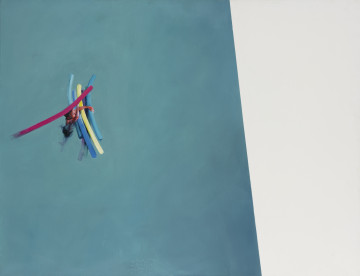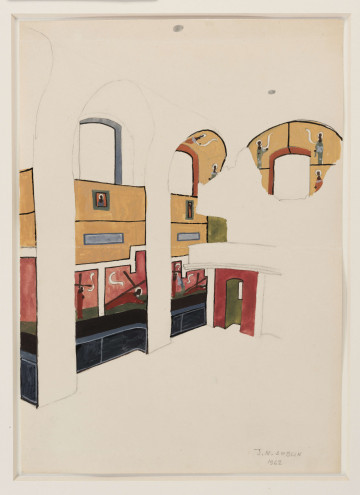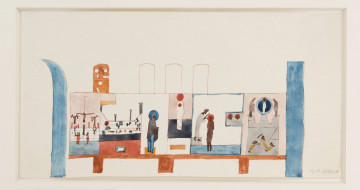
untitled
2010
National Museum in Szczecin
Part of the collection: European classics of modernity
Maria Jarema started her creative work from sculpting. It was not so much the result of her liking but choosing a charismatic master, Xawery Dunikowski, with whom she studied between 1929 and 1935 at the Academy of Art in Kraków.In the collection of the National Museum in Szczecin, there is one of her works from the series Wyrazy [Expressions], dating from 1956. It is a composition filled with figures overlapping each other. The shapes have been outlined with a precise black contour (monotype) and overlaid with elements of colour planes in vertical sequences. One of the key elements creating the image is colour. On the left, we see violet, then red, and further on, shades of violet, pink and greyish brown appear interchangeably. The series comprises almost exact human shapes (often resembling skulls or faces), marked only by a set of lines and dashes. These are monotypes, schemes devoid of individual features. The human body fascinated Jarema. She focused primarily on muscles, which she often distinguished with a weave of lines. They are placed in abstract spaces filled with other forms. She introduces them into a new, established by her, order of reality. They are sometimes interpreted as poetic visions, sometimes full of peace and harmony, at other times - quite the opposite. In the case of Szczecin's tempera, the arrangement of forms loses its transparency due to colourful shapes superimposed on it, as if cut pieces of paper. Instead of harmony, what we have is rather an interweaving, or even more, a tangle of the depicted elements. Part of this entanglement falls in places described as neck patterns, which evokes associations with suffocation. The series Wyrazy comes from the period of the flourishing of Jarema's creativity, who, having learnt about her serious illness (she suffered from leukaemia and died in 1958), devoted herself entirely to artistic work, gaining at that time a sign of certain courage and freedom. Critics see her uniqueness against the background of European art (which she studied systematically) because her works have little in common with geometric abstraction or Informel but balance on the border between figurative representation and abstract sign. Jarema has shown her search in several fundamental problems of the painterly struggle while creating a collection of individual works.
Beata Małgorzata Wolska
Author / creator
Dimensions
cały obiekt: height: 108 cm, width: 86 cm
Object type
painting
Creation time / dating
Creation / finding place
Identification number
Location / status

2010
National Museum in Szczecin

1962
National Museum in Lublin

1962
National Museum in Lublin
DISCOVER this TOPIC
National Museum in Szczecin
DISCOVER this PATH
Educational path